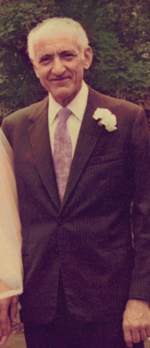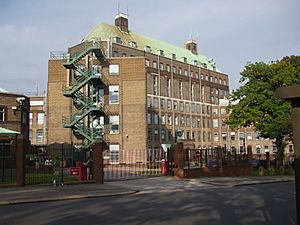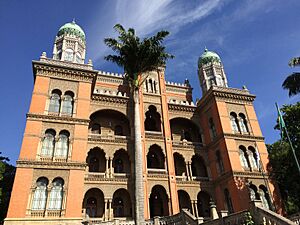Hélio Gelli Pereira facts for kids
Quick facts for kids
Helio Gelli Pereira
|
|
|---|---|

Helio Gelli Pereira (1918-1994)
|
|
| Born | September 23, 1918 |
| Died | August 16, 1994 (aged 75) |
| Nationality | Brazilian, British |
| Citizenship | Brazilian, British |
| Alma mater | Faculdade Fluminense de Medicina, Fundação Oswaldo Cruz (FIOCRUZ), Manchester University |
| Known for | Co-authorship of Antigens and structure of the adenovirus paper, co-authorship and editing of Viruses of Vertebrates title |
| Awards | Carlos J. Finlay Prize for Microbiology (1987) |
| Scientific career | |
| Fields | Virology |
| Institutions | Fundação Oswaldo Cruz (FIOCRUZ), National Institute for Medical Research (NIMR), Animal Virus Research Institute in Pirbright, National Center for Infectious Diseases (CDC), Common Cold Unit |
| Signature | |
 |
|
Hélio Gelli Pereira (born September 23, 1918 – died August 16, 1994) was a scientist who studied viruses. He was from both Brazil and Britain. Pereira was especially good at studying adenoviruses. He won the 1988 UNESCO Carlos J. Finlay Prize for Microbiology. He was also well-known for his work on the book Viruses of Vertebrates. Helio Pereira helped the field of virology through his research and by working for international public health.
Contents
Early Life and Education
Helio Pereira was born in 1918 in Petrópolis, a town in Brazil. His father was Portuguese, and his mother was Italian. He spent his early years in Petrópolis.
In 1924, he started primary school in Rio de Janeiro. Later, in 1928, he moved to the Anglo-American School. This school did not have good science facilities. Despite this, Pereira went on to study medicine in Niterói.
The school in Niterói also lacked good science equipment. However, his teachers were very encouraging. Pereira worked hard to earn a degree in microbiology. He also worked part-time at a hospital lab. In 1941, he earned his medical diploma.
The next year, he began a special course in biology. This was at the Instituto Oswaldo Cruz. After serving in the military, Pereira returned. He graduated with high honors.
Starting His Career
In 1943 and 1944, Pereira held several part-time jobs. These included working in hospital labs. He also assisted in microbiology and neurology. He wanted to do more than routine work. So, he received a scholarship to study microbiology in the UK.
In England, he worked at the University of Manchester. There, he learned from important scientists. These included Hugh Bethune Maitland, a virus expert. He also worked with Samuel Tertius Cowan, who studied bacteria. Pereira then spent a short time at Liverpool University.
After eight months, Pereira moved to London. He worked at the National Institute for Medical Research (NIMR). He spent a year learning from Christopher Andrewes. Pereira said this time was very rewarding. It made him want to do more laboratory research.
He got married in 1946. The next year, he returned to Rio de Janeiro. He started working at a government hospital. But he soon left this job. He joined a research team at the Instituto Oswaldo Cruz. They were studying rickettsia, a type of bacteria. Pereira found the work there very exciting. He helped show that certain diseases were present in Rio de Janeiro. His team also found new ways to study how the body fights rickettsia.
Important Discoveries and Work
Studying the Common Cold

Pereira felt frustrated by politics at the institute. So, in 1951, he moved back to Britain. He joined the Common Cold Unit in Salisbury. He worked with Christopher Andrewes again. Their team tried to grow the common cold virus in the lab. Pereira was successful at this.
In 1953, Pereira grew a common cold virus in the lab for the first time. He didn't realize how important this was at the time. He then started studying adenoviruses. He did important work on these viruses too. He studied their molecular structure. He even took pictures of the virus with an electron microscope.
In 1957, he became a British citizen. He and his wife moved to Mill Hill.
Fighting Influenza
Pereira returned to Brazil in 1960. He worked at the University of Brazil. He also visited England often. He traveled to Italy to study avian influenza, or bird flu. This was a big research interest for him. He showed that human and bird flu viruses could mix. He also suggested that bird flu might cause human pandemics.
In 1961, Pereira's work was recognized. He became a director of the World Influenza Centre. This was during the Asian flu pandemic. He tracked how the virus changed using samples from around the world. The Hong Kong flu pandemic in 1968 showed that new strains were responsible. With his wife, Peggy, he helped find ways to identify new flu strains. This helped create future vaccines.
In 1973, Pereira left the National Institute for Medical Research. He moved to the Pirbright Institute. He wanted to study how viruses compare across different animals. He led a new department there. It focused on studying animal diseases and developing vaccines. He enjoyed doing research there without much administration. That year, he became a Fellow of the Royal Society.
Later Research
Pereira retired from the Pirbright Institute in 1979. He then became a science consultant at the Instituto Oswaldo Cruz. There, he worked on the AIDS virus. He traveled between the UK and Brazil.
From 1979 to 1985, he helped young scientists. He advised them on local health problems. He also found new viruses with his colleagues. His wife, Peggy, studied viruses causing breathing illnesses in children in Rio de Janeiro. They helped the World Health Organization with their work on respiratory diseases.
Later Life and Legacy
In 1987, Pereira and his wife Peggy were in a serious car accident. Peggy died, and he was badly hurt.
In the late 1980s, Pereira was a visiting professor. He taught at the University of London's St George's Medical School. He also worked at the Centers for Disease Control in Atlanta. He studied unusual viruses found in patients in Brazil. Helio Pereira died in 1994 from heart failure.
Personal Life
In 1946, Pereira married Marguerite "Peggy" Scott. They had one son and two daughters. Their son, Raul Scott, became an immunologist.
Pereira was known for his kind and friendly nature. People described him as gentle and warm. He had a great sense of humor. He was also good at making lifelong friends with other scientists. His work greatly helped science and human health.
Honors
- Associate Founding Fellow of TWAS
- 1973 Fellow of the Royal Society
- 1975 Fellow of the Institute of Biology
- 1987 Carlos Findlay Prize, UNESCO
Appointments
- Member, Governing Body of the Animal Virus Research Institute
- Member, Committee on Immunological Products Control
- Member, Council of the Society for General Microbiology
- Member, Executive Committee of the International Committee for the Nomenclature of Viruses
- Chairman, Vertebrate Virus Subcommittee of the International Commission for the Nomenclature of Viruses
- Vice-Chairman, International Committee for the Taxonomy of Viruses; Life Member
- Member, WHO Expert Advisory Panel on Virus Diseases
- Member, WHO Animal Virus Characterization Board
- Member, Ad Hoc Committee on Non-Oncogenic Viruses of INSERM
- Member, Scientific Advisory Committee of the Pan American Foot and Mouth Disease Center


